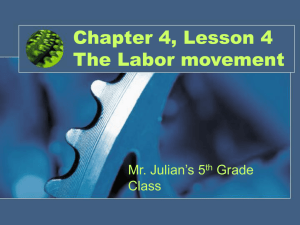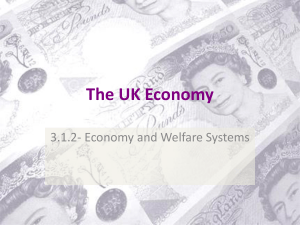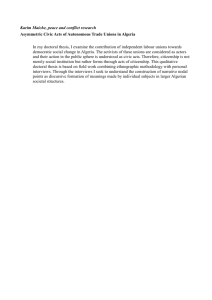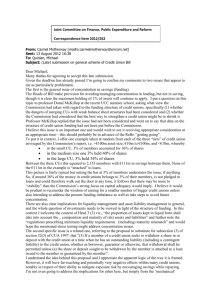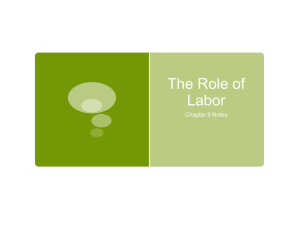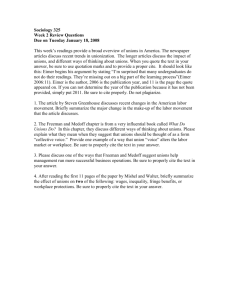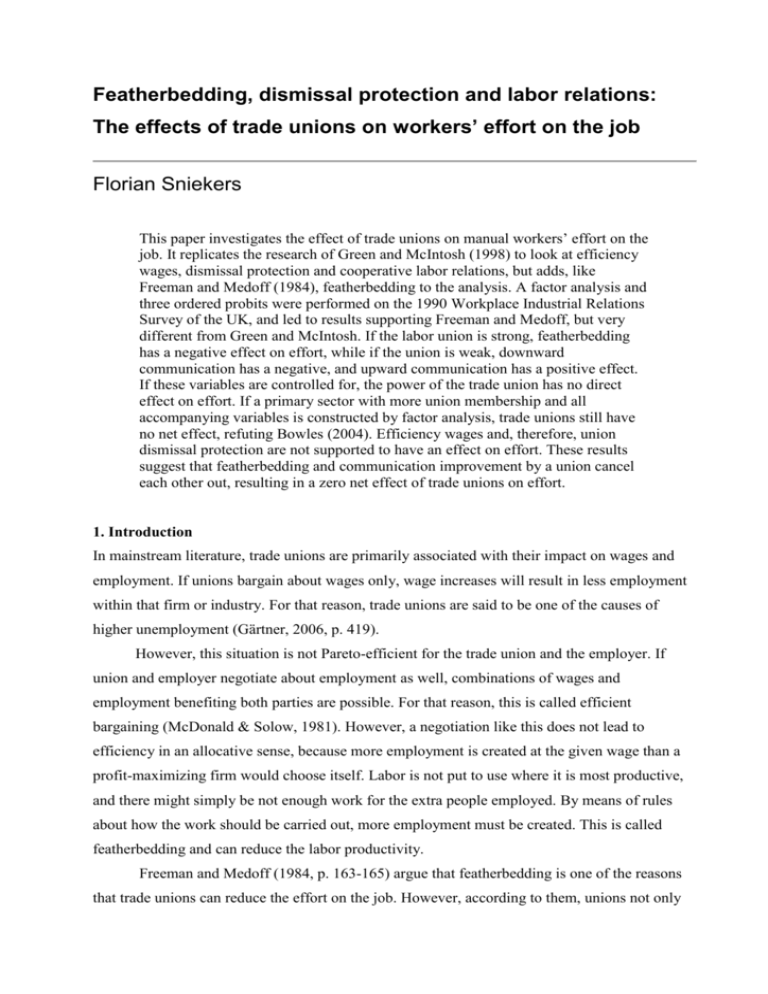
Featherbedding, dismissal protection and labor relations:
The effects of trade unions on workers’ effort on the job
Florian Sniekers
This paper investigates the effect of trade unions on manual workers’ effort on the
job. It replicates the research of Green and McIntosh (1998) to look at efficiency
wages, dismissal protection and cooperative labor relations, but adds, like
Freeman and Medoff (1984), featherbedding to the analysis. A factor analysis and
three ordered probits were performed on the 1990 Workplace Industrial Relations
Survey of the UK, and led to results supporting Freeman and Medoff, but very
different from Green and McIntosh. If the labor union is strong, featherbedding
has a negative effect on effort, while if the union is weak, downward
communication has a negative, and upward communication has a positive effect.
If these variables are controlled for, the power of the trade union has no direct
effect on effort. If a primary sector with more union membership and all
accompanying variables is constructed by factor analysis, trade unions still have
no net effect, refuting Bowles (2004). Efficiency wages and, therefore, union
dismissal protection are not supported to have an effect on effort. These results
suggest that featherbedding and communication improvement by a union cancel
each other out, resulting in a zero net effect of trade unions on effort.
1. Introduction
In mainstream literature, trade unions are primarily associated with their impact on wages and
employment. If unions bargain about wages only, wage increases will result in less employment
within that firm or industry. For that reason, trade unions are said to be one of the causes of
higher unemployment (Gärtner, 2006, p. 419).
However, this situation is not Pareto-efficient for the trade union and the employer. If
union and employer negotiate about employment as well, combinations of wages and
employment benefiting both parties are possible. For that reason, this is called efficient
bargaining (McDonald & Solow, 1981). However, a negotiation like this does not lead to
efficiency in an allocative sense, because more employment is created at the given wage than a
profit-maximizing firm would choose itself. Labor is not put to use where it is most productive,
and there might simply be not enough work for the extra people employed. By means of rules
about how the work should be carried out, more employment must be created. This is called
featherbedding and can reduce the labor productivity.
Freeman and Medoff (1984, p. 163-165) argue that featherbedding is one of the reasons
that trade unions can reduce the effort on the job. However, according to them, unions not only
2
have a negative impact on effort. Trade unions can also increase the engagement of the workers
and improve the possibilities for communication between employer and employees. The effort
on the job will be increased when the trade union contributes to cooperative labor relations.
Consequently, the question is then whether the first or the second effect on effort dominates.
Freeman and Medoff argue that both effects cancel each other out.
However, effort on the job might be influenced by the level of pay as well. If one
assumes that effort is only imperfectly observable and not verifiable, efficiency wages come into
consideration (see e.g. Shapiro & Stiglitz, 1984). Effort cannot be enforced, but the employer can
dismiss a worker thought to be shirking. By offering wages higher than the best alternative, the
worker gets a cost of losing his job. To avoid these costs, he or she increases his efforts at higher
wages.
Bulkley and Myles (1996) show that if trade unions negotiate wages, and efficiency
wages apply, the effort is higher than in the situation of complete competition without a trade
union. Even if the union negotiates about the effort level for dismissals as well, effort can still
increase. In such a bargain, easily contractible efforts will indeed decrease, but by increasing
wages, imperfect observable efforts have to rise as part of the deal to compensate for the
increased cost of job loss. In these cases, the employer still determines employment and is
responsible for the monitoring of the workers.
Apparently, workers would like to increase the wage even if they have to provide more
effort for it. However, they cannot increase their wage more, even if their higher effort would
generate enough revenues (pay for itself), because for the employer effort is non-verifiable, and
he or she cannot be sure that a higher wage indeed will be compensated by enough effort.
Consequently, as Bowles points out (2004, p. 277, 278), this situation is Pareto-inefficient. 1
However, if in some way a higher effort and wage can be contracted, circumventing the
enforceability problem, a Pareto-improvement is possible. As was the case for efficient
bargaining, according to Bowles (2004, p. 283, 284) again a trade union can make this
improvement. He argues that a union can bargain with the employer for a higher wage and a
higher effort, and enforce the efforts of the workers by peer monitoring. In this way, a union can
contribute to cooperative labor relations and reduce the number of dismissals for cause. For
Bowles (2004, p. 286), this explains the existence of primary labor markets.
Sampson (1993) even assumes that trade unions negotiate wages, employment, and effort
at the same time, but arrives at similar conclusions. If trade unions can be held responsible for
1
In fact, this is one of the reasons Bowles (2004, p. 269) wants to avoid the name efficiency wages.
3
effort levels, reducing the opportunities for free-riders, a situation of profit-sharing and high
levels of efforts can be reached. In addition, Bandyopadhyay (1997) shows within an infinite
game theoretic model, that a cooperative outcome with higher wages, more employment and
higher effort levels is possible.
However, Green and McIntosh (1998) argue that next to effects on wages, employment,
and effort in the ways described above, trade unions have an impact on dismissal protection as
well. In sectors with a strong representation of trade unions, it is harder to dismiss a worker. This
allows free-riders to enter the game again. Similarly, one can imagine that a trade union without
peer monitoring might want to reduce the employer’s monitoring, to alleviate the pressure of the
cost of job loss. Bowles (2004, p. 294) too acknowledges that the secondary labor market is
characterized by stronger labor discipline effects. Green and McIntosh conclude that trade unions
have no net impact on the efforts of manual workers. On the one hand union members do not
provide much effort because they have protection against dismissal, on the other hand
cooperative labor relations (as with Bowles) and human resource management contribute to more
efforts.
This research replicates the research of Green and McIntosh (1998) to examine the
impact of efficiency wages, dismissal protection and cooperative labor relations in the presence
of trade unions, thereby including the possibility of Pareto-improving cooperation. On top of that,
this study adds featherbedding to the analysis, in imitation of Freeman and Medoff (1984). With
all these factors together, this research can offer an answer to the question what the effect is of
trade unions on effort on the job.
Paragraph 3 will discuss the data for this study, data that Green and McIntosh (1998)
already used. Paragraph 4 pays attention to the methodology. The results will be discussed in
paragraph 5, whereupon in paragraph 6 can be concluded what the effect is of trade unions on
workers’ effort. First, in the next paragraph the theoretical model is discussed.
2. Theoretical model
Maybe the most common assumption in labor economics is that workers prefer to provide less
effort e, at least in the economically relevant ranges (Bowles, 2004, p. 271), and prefer to earn a
higher wage w:
U f (e, w), f e 0, f w 0 .
4
It is in the employer’s interest to induce as much effort as possible for lower spending on wages,
monitoring or other techniques. However, since effort is hard to verify, in many cases it is
impossible to incorporate this in a contract.
As said, an employer can increase effort by paying efficiency wages, in this way
generating a cost of job loss. Workers will provide more effort to prevent their dismissal, if their
current job pays more than the weighted average of the chances of the best alternative or
unemployment. Unemployment results in a benefit, a situation which occurs with the chance of
the unemployment rate, and the best alternative is the wage of another employer, a situation
occurring with the complementary chance. Then, the cost of job loss cjl results in:
cjl w p u b (1 p u ) w
in which w is the current wage, pu is the unemployment rate, b the unemployment benefit and
w the wage of the best alternative.
In negotiating wages, a trade union will either as unintended part of the bargain, or as part
of a negotiated Pareto-improvement, increase effort. The latter is the Bowles’ (2004, p. 284)
causal chain of cooperative labor relations. The former is the pure effect of an increased cost of
job loss. According to Green and McIntosh (1998), at the same time, trade unions limit the
possibilities for dismissal, and therefore reduce effort. Moreover, a trade union that is not only
interested in a higher wage, but also in the level of employment, will try to introduce
featherbedding practices. Because of this, the effort is reduced further. However, Freeman and
Medoff (1984, p. 163) argue that trade unions might improve the communication between
employer and workers and increase involvement, contributing to cooperative labor relations. In
figure 1, all these effects are presented as follows:
Figure 1 Causal chain of trade unions on effort
Wage
+
Trade union
+
Cost of job loss
+
+
Featherbedding
+
-
Effort
+
Cooperative labor relations
Next to the impact of trade unions on effort on the job, other factors have an effect on effort as
well. For instance, an employer can improve the human resource management hrm to increase
5
the involvement, and as a result of that, the effort of the workers. Human resource management
can contain several components, such as communication and consultation, but always consists of
methods associated with the ‘carrot’ rather than the ‘stick’ (Green & McIntosh, 1998, p. 367).
Omitting technical and demographical control variables for the moment, this results in the
following model of effort e:
e f (cjl, F , clr , hrm), f cjl (u ) 0, f F (u ) 0, f clr (u ) 0, f hrm 0,
in which F stands for featherbedding and clr for cooperative labor relations. The hypotheses of
this study concern the signs of the first three coefficients, and the impact of trade unions on them,
as presented in figure 1 above. The next paragraph discusses the data for this study.
3. Data
This study can be conducted with micro data at the company level. The most important variable
is the effort on the job. It is very hard to measure this variable objectively, and for that reason
this research is limited to subjective data. However, even then datasets seldom contain questions
concerning effort, as a result of which this study must be conducted with relatively old data, the
Workplace Industrial Relations Survey of 1990. This survey is the largest and most detailed
survey concerning labor relations in Great Britain, covering 2061 companies with more than 25
employees. The survey contains interviews with managers, representatives of manual workers,
and workers themselves. The range of this survey permits a study of all mentioned effects on
effort.
Effort is measured on a five-point scale by a workers’ representative, comparing the
intensity of their work with the intensity in other companies. The representative was in all but
five cases a union official, who is assumed to be able to make such a comparison, since he or she
has to negotiate about it. Although a subjective variable is concerned, Green and McIntosh (1998,
p. 368, 369) show for this dataset that the problems of social-desirable answers, an unclear
reference point, and an unclear meaning of `intensity’ are not large. Moreover, in a consistencycheck the intensity correlates with the productivity. For these reasons, this effort variable seems
appropriate for this study.
Because the representative is almost always a union official, no comparison can be made
between companies without and with a trade union. Instead, in imitation of Green and McIntosh
(1998, p. 372), this study makes a distinction between companies which are only accessible for
trade union members (a closed shop) and companies with recommend membership on the one
6
hand, and all other companies on the other hand. This reflects the strength of the union, and the
possibilities for cooperation.
This dataset also contains data concerning the incomes and the hours worked, whereupon
wages can be calculated as the weighted average of all manual workers. With the regional
unemployment rate of 1991 (unfortunately 1990 cannot be found) of the Office for National
Statistics in the United Kingdom, the costs of losing a job can be constructed. The regional
distinction is based on the eleven government office regions.2
The survey of the managers investigates whether a number of aspects of human resource
management are applied in the company concerned. Consequently, they are asked whether they
undertook attempts to increase the involvement of the employees in the past three years, and
whether a Joint Consultative Committee (JCC) of managers and workers exists. Two-way
communication (meetings), downward communication (by the management chain or company
newsletters) and upward communication (surveys and suggestion schemes) are examined as well.
These variables result in five dummies.
In addition, managers are asked whether they negotiate about both wages and
employment, like efficient bargaining, and whether they feel themselves limited in control by
given rules about the implementation of the work, which can be called featherbedding. Besides,
it is asked how the labor relations can be described and whether people are dismissed for cause.
Therefore, this leads to an additional set of four dummies. Finally, the proportion of supervisors
with respect to manual workers is calculated. The remaining variables are control variables and
are discussed in the appendix.
Table 1 presents the means and standard errors of the variables considered, both for the
entire sample, and for those 232 observations which are eventually used since they have values
for all variables. Generally, the used sample tends towards a stronger trade union influence, more
human resource management, and more innovation in the management, but the differences
remain relatively small. However, the changes in the existence of a JCC, and the union density
are more doubtful. On top of that, on average only larger companies stay in the sample. Finally,
the proportion supervisors changes considerably as well, but that is because earlier measurement
errors of companies with only supervisors now turn out to be excluded. Unfortunately, the
number of observations is reduced considerably.
The means and the number of observations do not correspond with those of Green and
McIntosh (1998), although the same dataset has been used. Moreover, this study tries to replicate
2
North East, North West, Yorkshire and The Humber, East Midlands, West Midlands, East, London, South East,
South West, Wales, and Scotland.
7
the variables which are used in both studies as precise as possible. For that reason, the
differences that arise are hard to explain. Of course this study continues with the variables as
constructed here, so that, interestingly, other results can be expected as well. The next paragraph
will address how the variables can be applied.
Table 1 Averages and standard errors variables, for the entire and reduced sample
variable entire sample
observ.
mean
effort
655
3.731
union req./recomm.
1100
.486
average wage
1594
4.188
unemployment rate
2061
.0861
cost of job loss
1594 -1.085
worker involvement
2054
.498
JCC exists
2057
.454
2-way communication
2057
.760
commmunication down
2057
.817
communication up
2057
.456
result pay
2049
.823
union density
1668
.542
new machinery
1387
.549
new work practices
1387
.458
new microtechnology
1368
.397
incr. flexibility
2055
.482
good lab. relations
2053
.890
proportion male
1693
.635
prop. unskilled
1687
.469
prop. full time
1802
.755
proportion ethnic
1222
.349
prop. supervisors
1654
.916
size
2061
3.462
featherbedding
2027
.199
eff. bargaining
1104
.562
dismissals
2030
.631
232 observ.
s.e.
mean
s.e.
.873
3.759
.859
.500
.569
.496
1.225
4.421
1.104
.015
.0852
.014
.360
-1.025
.322
.500
.595
.492
.498
.75
.434
.427
.797
.403
.387
.944
.230
.498
.586
.494
.381
.647
.479
.421
.846
.203
.498
.690
.464
.498
.672
.470
.489
.578
.495
.500
.694
.462
.313
.879
.327
.355
.684
.327
.390
.432
.367
.328
.827
.263
.477
.237
.426
7.421
.189
.446
1.723
5.134
1.017
.400
.388
.488
.496
.668
.472
.483
.772
.421
4. Methodology
Because the effort variable is ordinal, it can only be estimated by an ordered probit, an
estimation method with coefficients very hard to interpret. Even the sign of the coefficients
cannot unambiguously be understood as the effects’ direction, but has a clear meaning at the
lowest and highest value of the variable only. At least, the ordered probit allows for some
interpretation.
In our theoretical framework, effort is a function of the variables described above. The
first of these was the cost of job loss. When, as is often assumed, the alternative wage is equal to
the current wage, and the unemployment benefit is a fraction ρ of that last wage, the equation is
cjl w p u w (1 p u )w . This can be reduced to cjl wp u (1 ), what is equal to the sum of
8
the logarithms of wages, the regional unemployment rate and a constant which for this reason
can be ignored. This variable allows us to test the effect of efficiency wages.
Second, featherbedding and efficient bargaining are included in the probit to estimate
their impact on effort. Third, few dismissals are an example of cooperative labor relations, as are
an explicit positive statement of these relations. Fourth, the five examples of human resource
management are included: the three varieties of communication, the existence of a JCC, and
attempts to increase workers’ involvement. Fifth, attention is paid to the proportion of
supervisors as a complementary way to generate more effort. Sixth, the strength of the trade
union is measured by the union density and whether the trade union is required or recommended,
or not. Finally a series of control variables is included, concerning organizational and
technological changes, the composition of the work force, and the size, region and industry of the
establishment.
This estimation gives us the direct effects of trade unions on effort if we control for all
the indirect effects described above. Since we cannot measure whether a Pareto-improvement in
wage and effort has been negotiated, this is the estimation that should show an increase in effort
for stronger unions, if we cannot control effectively for cooperative labor relations. By excluding
the strength of the trade union, but dividing the sample according to whether union membership
is required/recommended, or not, the indirect effects of trade unions can be distinguished.
However, it makes sense not to distinguish all effects, because certain effects generally
coincide. For instance, one can imagine a primary trade union sector combining several of the
effects above. For that reason, this study will also estimate the effect of trade unions by a number
of factors as explanatory variables. After a rotated factor analysis, these factors reflect latent
variables, or in our case, certain sectors. Possibly, the analysis of a primary sector gives us a
better insight in the net-effects of trade unions on effort on the job. The next paragraph discusses
the results.
5. Results
The first probit estimates the equation for effort such as presented in the theoretical model,
including a number of control variables, as can be seen in table 2. The first variable is the cost of
job loss. Against efficiency wage theory, this variable has no significant effect on the effort on
the job. Featherbedding however, is significantly bad for effort, but only at a significance level of
0.10. In addition, it must be noticed for all effects, that the direction of the effect only
corresponds unambiguously with the sign of the coefficient, at the lowest and highest value of
the ordinal variable for effort. On top of that, the pseudo R2 for this estimation is unusually low.
9
Cooperative labor relations have no significantly positive effect on effort. Also human
resource management instruments have little impact. Only upward communication has a positive
association with effort at a significance level of 0.10. At the same level, downward
communication has even a negative effect on effort. The proportion of supervisors and the
control variables have no significant effects. The strength of the trade union, as measured by the
union density, the square of the density and whether the trade union is required/recommended or
not, has no effect on effort, just as Green and McIntosh (1998, p. 376) show us. For that reason,
no direct effect of trade unions can be established if we control for our theoretical effects.
Table 2 Estimation results of ordered probit for effort
effort
dismissals
featherbedding
eff. bargaining
cost of job loss
worker involvement
JCC exists
2-way communication
commmunication down
communication up
result pay
union density
union density 2
union req./recomm.
new machinery
new work practices
new microtechnology
incr. flexibility
good lab. relations
proportion male
prop. unskilled
prop. full time
proportion ethnic
prop. supervisors
100-199 employees
200-499 employees
500-999 employees
1000+ employees
region
industry
observations
pseudo R2
coefficient
-.013
-.277^
-.210
-.356
.180
.141
-.282
-.740^
.361^
.101
-1.820
1.668
-.083
-.191
-.057
.285
.013
-.006
-.030
.307
-.301
.004
-.297
.746
.480
.406
.546
.
.
s.e.
.218
.167
.179
.454
.173
.192
.213
.379
.197
.182
2.235
1.613
.173
.283
.221
.270
.203
.260
.425
.279
.573
.227
.191
.683
.655
.635
.643
.
.
232
0.053
It can be noticed that the dummy for the size of the company of 50 up to 99 employees is omitted,
due to multicollinearity. The control group of 25 - 49 employees was already absent of course.
^ significant at a level of 0.10
10
In table 3 the sample is divided in establishments where membership of a trade union is
required/recommended, and establishments where that is not. Both estimates manage to achieve
a slightly higher pseudo R2, but these are still very small. In the ‘free’ sector the effect of the cost
of job loss is not significant, and neither are featherbedding, cooperative labor relations and the
proportion of supervisors. Only upward communication has a positive, and downward
communication has a negative effect on effort at a significance level of 0.05. The other human
resource management instruments are not significant, as all the control variables.
Table 3 Estimation results of ordered probit for effort, sample split for whether union is
required/ recommended or not
effort
trade union
dismissals
featherbedding
eff. bargaining
cost of job loss
worker involvement
JCC exists
2-way communication
commmunication down
communication up
result pay
new machinery
new work practices
new microtechnology
incr. flexibility
good lab. relations
proportion male
prop. unskilled
prop. full time
proportion ethnic
prop. supervisors
50-99 employees
100-199 employees
200-499 employees
500-999 employees
1000+ employees
region
industry
observations
pseudo R2
coefficient
s.e.
not required/recomm.
-.318
.371
-.195
.279
.335
.307
.029
.724
.406
.286
-.170
.303
-.146
.355
-1.272*
.573
.603*
.303
-.080
.308
.607
.471
-.505
.370
-.079
.439
-.095
.316
.621
.416
-.681
.635
.101
.460
-.198
.937
.062
.351
-.476
.381
2.456
.390
.671
.758
.
.
1.518
1.368
1.389
1.346
.
.
116
0.144
coefficient
s.e.
required/recommended
.222
1.142
-.546*
.243
-.679**
.262
.409
2.182
.398
.598
.120
.975
-.105
.287
-.572
.617
-.060
.302
.214
.834
-.587
.420
.017^
1.278
.525
1.069
-.221
.291
-.695^
.357
.404
2.067
.676
.836
-.876
.820
.422
.896
.389
.684
-.364
.882
-.560
.522
-.298
-.571
.
.
.395
.403
.
.
137
0.144
It can be noticed that two different dummies for the size of the company are omitted.
Multicollinearity explains these empty spots.
^ significant at a level of 0.10
* significant at a level of 0.05
** significant at a level of 0.01
11
In the trade union sector, featherbedding by rules concerning the implementation of the work,
and efficient bargaining about wages and employment, are, as expected, significantly bad for
effort, respectively at a level of 0.05 and 0.01. New work practices may increase effort, but
strangely good labor relations reduce effort, both only significant at a level of 0.10. Human
resource management instruments do not affect effort, and neither do the proportion of
supervisors and other control variables. There is nothing that points to the mutual benefit of a
cooperative labor relation. So far, the negative impact of trade unions seems to dominate,
although it is also possible that unions replace the positive impact of upward communication in
the ‘free’ sector, and reduce the negative impact of downward communication. Then, the trade
union is the communication link between workers and employer and vice versa. This might
facilitate upward communication, and perhaps makes downward communication more
reasonable for the workers.
The cost of job loss has no significant effect on effort, as Green and McIntosh (1998, p.
379) show us as well. They explain this by the thesis that trade unions offer effective protection
against dismissal, and for that reason protect workers against the disciplinary effects of the cost
of job loss. However, unlike this study, they did have a positive impact of this variable in the free
sector. The result that cost of job loss is not significant in both sectors, provides absolutely no
support for the thesis of Green and McIntosh (1998) that weaker unions offer less dismissal
protection for people who deliver too little effort.
To study the net-effect of trade unions, a principal factor analysis has been carried out
with all variables except the control dummies and the cost of job loss. The cost of job loss is
omitted, because the efficiency wage theory is the most important competing explanation, but
had no effect yet in our earlier results. In earlier analyses the control dummies dominated the
factors, as a result of which they were left out. As a result, two factors with an eigenvalue larger
than one remain, upon which is tried to catch the maximum variance for these two factors, by an
orthogonal oblimin rotation. The resulting eigenvalues are presented in table 4.
Table 4 Eigenvalues of factors larger than one, after rotation
factor
factor 1
factor 2
observations
eigenvalue
1.9792
1.9147
494
By studying the factor loadings in table 5, the first factor appears to correspond to a considerable
extent to a sector of ‘insiders’. Here is a large overrepresentation of skilled, full-time working
12
males, usually union member as well. For this reason, this factor is called the primary sector.
Remarkably, featherbedding and good labor relations are hardly and negatively part of this factor.
The second factor is mainly characterized by investments in new machines, micro technology,
new working practices, and increased flexibility. For this reason, this sector will be called the
technological sector. To some extent, this factor contains human resource management
instruments as well.
Table 5 Factor loadings for two factors with eigenvalue larger than one, after rotation
variables
dismissals
featherbedding
eff. bargaining
worker involvement
JCC exists
2-way communication
commmunication down
communication up
result pay
union density
union req./recomm.
new machinery
new work practices
new microtechnology
incr. flexibility
good lab. relations
proportion male
prop. unskilled
prop. full time
proportion ethnic
prop. supervisors
factor 1
0.0355
-0.0145
-0.0672
0.0281
-0.1370
-0.0590
-0.0682
0.0900
-0.2054
0.3992
0.1272
0.2108
0.0630
0.3014
0.0090
-0.0577
0.7662
-0.5551
0.8047
-0.1501
-0.1085
factor 2
0.2377
0.0884
0.1287
0.2980
0.2880
0.2160
0.3059
0.3482
-0.0296
0.2521
0.1500
0.6931
0.4808
0.6415
0.3942
0.0421
0.1103
-0.0674
0.1239
-0.0344
-0.0106
Finally, table 6 presents the estimation results for a probit of effort, explained by cost of job loss,
the two factors, and the control dummies. It turns out that this estimate has no single significant
result and has the lowest pseudo R2 of all estimations. The primary sector with its trade union
members does not provide more or less effort, possibly also because featherbedding has only a
small loading in this factor. Bowles’ (2004, p. 284) theory of bargained Pareto-improvements in
the primary sector is not supported. Remarkably, new investments and human resource
management fails to generate more effort as well, possibly because downward communication
cancels out the impact of upward communication.
13
Table 6 Estimation results for ordered probit of effort, with two factors
effort
cost of job loss
primary sector
techn. sector
100-199 employees
200-499 employees
500-999 employees
1000+ employees
region
industry
observations
pseudo R2
coefficient
.365
.073
.116
.654
.310
.369
.266
.
.
s.e.
.405
.174
.285
.643
.360
.341
.344
.
.
232
0.018
6. Conclusion
This study replicated the research of Green and McIntosh (1998) to examine the impact of
efficiency wages, dismissal protection and cooperative labor relations in the presence of trade
unions, thereby including the possibility of Pareto-improving cooperation. On top of that, this
study adds featherbedding to the analysis, in imitation of Freeman and Medoff (1984). All these
factors together provide an answer to the question what the effect is of trade unions on effort on
the job. The data are limited to manual workers and make a comparison between companies with
and without trade union impossible. Instead, this study makes a distinction between companies
requiring or recommending a union membership, and companies that don’t. Although the
Workplace Industrial Relations survey of 1990 is the same dataset as Green and McIntosh (1998)
used, the results can hardly be different.
In the first ordered probit it becomes clear that no direct effects of trade unions exists, if
we control for our theoretical effects. Consequently, there is nothing that points to the mutual
benefit of a cooperative labor relation, as in Bowles (2004, p. 284). However, it becomes clear
that effort is positively affected by upward communication, but negatively by downward
communication and featherbedding. If the sample is divided between establishments
requiring/recommending a trade union membership and those that don’t, the two probits show
that featherbedding and efficient bargaining are especially bad for effort in the trade union sector,
and that communication shows its effects mainly in the ‘free’ sector. However, the cost of job
loss and the proportion supervisors are not significant in both sectors. This contradicts efficiency
wage theory and offers no support for the thesis of Green and McIntosh (1998) that trade unions
provide better dismissal protection.
14
If factor analysis is used to study the impact of multiple correlated variables, it shows that
human resource management in a technological sector does not contribute to effort. This is
probably due to the fact that upward and downward communication cancel each other out. Even
a primary sector has no net effects on effort, although featherbedding has no strong loading in
this factor. Again, Bowles’ (2004, p. 284) theory of bargained Pareto-improvements in the
primary sector is not supported.
In the factor analysis, trade unions appear to have no clear net effects, as Green and
McIntosh (1998) argue as well, but this is not caused by the cancelling out of cooperative labor
relations and dismissal protection as they argue. It is rather the inverse effects of featherbedding
and communication. This resembles Freeman and Medoff (1984), although they don’t
distinguish the negative impact of downward communication.
The size of the net-effect cannot be exactly determined in this study, and this certainly
asks for more research. The opportunity exists that trade unions can replace the positive impact
of upward communication and can reduce the harm of downward communication. In that case, it
is possible to compensate the obvious negative influence of featherbedding on the effort on the
job. Possibly, qualitative research in companies, concerning the role of trade unions in
communication flows, can illuminate this.
Bibliography
Bandyopadhyay, S. (1997). Endogenous effort in a dynamic model of union-firm interaction.
Scottish Journal of Political Economy, 44, (3), 280-297.
Bowles, S. (2004). Microeconomics: behavior, institutions, and evolution. Princeton: Princeton
University Press.
Bulkley, G., en Myles, G. (1996). Trade unions, efficiency wages, and shirking. Oxford
Economic Papers, 48, 75-88.
Freeman, R., en Medoff, J. (1984). What do unions do? New York: Basic Books.
Gärtner, M. (2006). Macroeconomics. Harlow: Pearson, Prentice Hall.
Green, F., en McIntosh, S. (1998). Union power, cost of job loss and workers’ effort. Industrial
and Labor Relations Review, 51, (3), 363-383.
McDonald, I., en Solow, R. (1981). Wage bargaining and employment. American Economic
Review, 71, 896-908.
Sampson, A. (1993). Bargaining over effort and the monitoring role of unions. European Journal
of Political Economy, 9, 371-381.
15
Shapiro, C., en Stiglitz, J. (1984). Equilibrium employment as a worker discipline device.
American Economic Review, 74, 433-443.
Appendix
Construction remaining control variables:
Paid by results: A dummy whether manual workers are paid by their results.
Union density: The proportion of trade union members in the total of manual workers.
New machinery: A dummy whether in the past three years new machines are introduced.
New work practices: A dummy whether new work practices are introduced in the past three
years, without the introduction of new machinery.
New micro technology: A dummy whether new micro technology is introduced in the past
three years.
Increased flexibility: A dummy whether in the past three years the work has been made more
flexible.
Proportion male, in all manual workers
Proportion unskilled, in all manual workers
Proportion full timers, in all manual workers
Proportion manual workers from an ethnic minority
Size of the establishment: ordinal variable adapted as series of dummies, categorizing the
number of employees from 25-49, 50-99, 100-199, 200-499, 500-999 to 1000 or more.
Region: A series of dummies indicating in which of the eleven regions the establishment is
located.
Industry: A series of dummies indicating to which of the nine industries the company
belongs.




